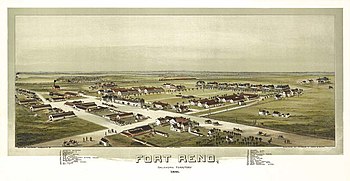Fort Reno (Oklahoma)
| Fort Reno | |
|---|---|
| Indian Territory / Canadian County, Oklahoma, USA (near El Reno, Oklahoma) |
|

Aerial view of Fort Reno, 1891.
|
|
| Type | Fort |
| Site information | |
| Controlled by | United States |
| Site history | |
| Built | 1875 |
| In use | 1875–1949 |
| Materials | Wood, stone, & brick |
| Battles/wars | Indian Wars on the Southern Plains; Remount Station, World War I & World War II; German Prisoner of War camp, World War II. |
|
Fort Reno
|
|
 |
|
|
Location in Oklahoma
|
|
| Nearest city | El Reno, Oklahoma |
| Coordinates | 35°33′42″N 98°2′6″W / 35.56167°N 98.03500°WCoordinates: 35°33′42″N 98°2′6″W / 35.56167°N 98.03500°W |
| Area | 9.9 acres (4.0 ha) |
| Built | 1874 |
| NRHP Reference # | 70000529 |
| Added to NRHP | June 22, 1970 |
Fort Reno is a former United States Army cavalry post west of El Reno, Oklahoma. It is named for General Jesse L. Reno, who died at the Battle of South Mountain in the American Civil War.
Fort Reno began as a temporary camp in July 1874 near the Darlington Agency, which needed protection from an Indian uprising that eventually led to the Red River War. After the conflict ended, the post remained to control and protect the Southern Cheyenne and Southern Arapaho reservation, and Fort Reno was established as a permanent fort on July 15, 1875. Soldiers from Fort Reno also attempted to control Boomer and Sooner activity during the rush to open the Unassigned Lands for settlement. Among the units stationed here were the famed Ninth Cavalry of Buffalo Soldiers. The fort lent its name to the city of El Reno, which still exists, as well as Reno City, which was abandoned before Oklahoma statehood.
After Oklahoma statehood in 1907, the post was abandoned on February 24, 1908, but remained as a quartermaster remount depot. During World War II, German and Italian prisoners of war were housed on the grounds; the fort's chapel was built by members of the Afrika Korps. In 1949, the fort was abandoned by the Army and transferred to the U.S. Department of Agriculture, which uses it as its Grazinglands Research Laboratory. The laboratory's mission is to develop and deliver improved technologies, management strategies, and strategic and tactical planning tools which help evaluate and manage economic and environmental risks, opportunities, and tradeoffs, for integrated crop, forage, and livestock systems under variable climate, energy and market conditions.
...
Wikipedia


